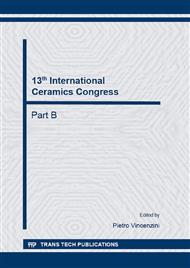p.104
p.111
p.121
p.131
p.139
p.148
p.156
p.162
p.172
Influencing Factors on the Reactive Wetting of Cu-Sn-Ti- and Ag-Cu-Ti-Alloys on Silicon Carbide – Microstructural Observations, Effects and Multivariate Modelling
Abstract:
Despite the fact that active brazing is a suitable and well-established method to join ceramics to each other and to metals, issues concerning possible influences on the wetting properties of the used filler alloys are not yet entirely clarified. It is well known that process parameters such as the temperature, the surface roughness of the ceramic, and the atmosphere during wetting influence the wetting angle and the spreading kinetics of the molten filler metal. However, a quantitative description of these influences is still missing.This study closely investigates the isolated effects of the temperature, the surface roughness of the ceramic, as well as the atmosphere on the wetting of Ag-Cu-Ti and Cu-Sn-Ti on silicon carbide. In order to evaluate the effects of the considered factors as well as their interdependencies, a multivariate statistical approach is employed and a linear regression model for both, the contact angle and the spreading area, will be derived. Besides quantitative measurements of the contact angle on solidified sessile drops, microstructural and chemical aspects will be discussed and connected to the results of the wetting experiments as well. By these means, valuable information can be obtained, which lead to a profound understanding concerning changes of the wetting behavior. Furthermore, the study allows a comparison of measurements carried out using varying experimental conditions.
Info:
Periodical:
Pages:
172-177
Citation:
Online since:
October 2014
Authors:
Price:
Сopyright:
© 2014 Trans Tech Publications Ltd. All Rights Reserved
Share:
Citation:


